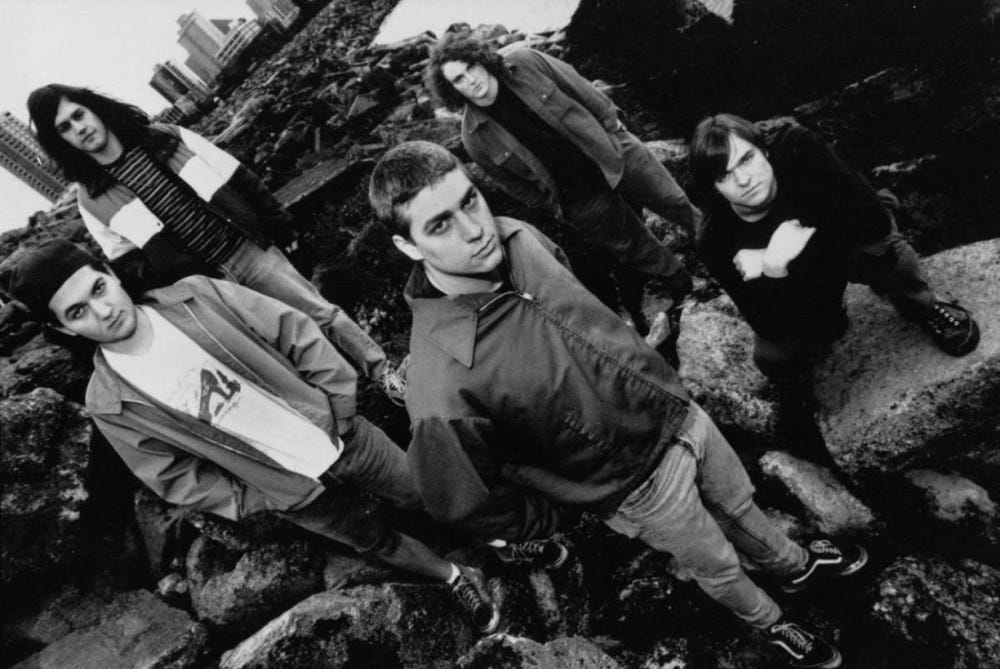Seaweed | History of the Band
Tacoma’s Punk Pioneers Who Brought Heart and Hooks to the 90s Scene.
The 90s were a swirling mix of punk ethics and alternative experimentation, and somewhere in that beautiful chaos stood Seaweed. Hailing from Tacoma, Washington, the band fused hardcore energy with melodic sensibilities, creating a sound that was as intense as it was approachable. For a moment, they were one of the brightest sparks in the underground scene, leaving an indelible mark on fans and future musicians alike.
Let’s dive into their journey through the 90s, an era that saw Seaweed release some of their most compelling work, evolve their sound, and flirt with the mainstream while staying true to their punk roots.
Jeremy Amend suggested this artist for a future Dig Me Out podcast episode. Each month, our Patrons are presented with a selection of albums suggested by listeners and asked to vote for their favorite.
Formation and Early Years
Seaweed formed in Tacoma, Washington, in 1989 with Aaron Stauffer (vocals), Clint Werner (guitar), Wade Neal (guitar), Bob Bulgrien (drums), and John Atkins (bass). Inspired by hardcore bands like Black Flag and Hüsker Dü, they brought a raw yet tuneful energy that quickly set them apart. Notably, John Moen, later associated with The Decemberists, was not an original member of the band.
Their early singles, including “Just a Smirk” and “Deer Trap,” were released through independent labels, and their relentless live shows made them a fixture in the Pacific Northwest scene. Signing with Sub Pop Records in the early 90s helped Seaweed gain visibility alongside contemporaries like Nirvana and Mudhoney, but their sound always leaned more toward melodic hardcore than grunge.
Musical Style and Evolution
Seaweed’s music packed a visceral punch from the start, driven by their hardcore roots. However, their sound evolved through the 90s, balancing ferocity with melodic nuance. Early on, they crafted unrelenting, high-energy tracks fueled by buzzsaw guitars and Stauffer’s impassioned vocals. By the mid-90s, their songwriting became more sophisticated, as evidenced by albums like Spanaway.
Their evolution wasn’t a departure from punk but a broadening of their sonic palette. They retained the aggression that defined their early work but began incorporating dynamic shifts, layered guitar work, and anthemic choruses.
Discography and Notable 90s Albums
“Despised” (1991, Sub Pop)
Raw, unrelenting, and unapologetically punk, Despised introduced Seaweed as a force to be reckoned with. Tracks like “Inside” and “Undertow” captured their live energy, while Jack Endino’s production highlighted their ferocious sound.
“Weak” (1992, Sub Pop)
With Weak, Seaweed found their footing. This album showcased their ability to fuse melody with hardcore aggression, as heard on “Baggage” and “Recall.” Critics noted the band’s knack for maintaining punk ethos while crafting accessible songs.
“Four” (1993, Sub Pop)
The aptly titled Four marked a turning point for Seaweed. Tracks like “Bill” and “Kid Candy” reflected their growing ambition and earned exposure on MTV and the cult show Beavis and Butt-head. Self-produced by the band, the album expanded their audience without sacrificing their authenticity.
“Spanaway” (1995, Hollywood Records)
Signed to Hollywood Records, Seaweed delivered Spanaway, an album that blended punk roots with polished alt-rock production. Featuring standout tracks like “Start With” and “Magic Mountainman,” it marked their most commercially ambitious effort. Their cover of Fleetwood Mac’s “Go Your Own Way” gained attention on the Clerks soundtrack, further broadening their reach. “Start With” also charted at No. 38 on Billboard’s Alternative Songs chart.
“Actions and Indications” (1999, Merge Records)
Returning to their indie roots, Seaweed released Actions and Indications on Merge Records. This album leaned into introspective themes, with tracks like “Steadfast Shrine” showing a matured band reflecting on their journey. It was their final album of the 90s before disbanding in 2000.
Seaweed never fully escaped the shadow of the Seattle grunge explosion, but they carved out their own loyal audience. Their ability to fuse grit with melody earned praise from Alternative Press and Maximum RocknRoll. Critics admired their refusal to compromise, noting that even their most accessible work retained a raw edge. Despite mainstream flirtations, Seaweed remained a cult favorite—an underground gem treasured by fans who valued their authenticity.
Influence and Legacy
Seaweed’s legacy lies in the bands they influenced and the fans they inspired. Their seamless blend of hardcore energy and melodic songwriting paved the way for 90s emo and post-hardcore bands like Sunny Day Real Estate and Jimmy Eat World. Their work also resonated with punk purists who appreciated their unwavering ethos.
After disbanding in 2000, Seaweed reunited periodically, performing live until 2014. They released singles like “Service Deck”/“The Weight” in 2011, maintaining relevance in indie circles. Members pursued other projects, with John Atkins forming 764-HERO and Aaron Stauffer collaborating on various music ventures.
Seaweed encapsulates everything vibrant and authentic about 90s underground music. They were never the biggest band on the scene, but their fearless blend of punk aggression and melodic depth made them a crucial piece of the 90s puzzle. Listening to their music today feels like rediscovering an old mixtape—raw, immediate, and timeless. For fans of the era, Seaweed remains a touchstone, reminding us that some of the best bands didn’t dominate charts—they dominated hearts.




Great article, great band. Four was being spun just this week! Thanks!
I saw them around 2001 at a coffee shop in Sacramento. Great show.